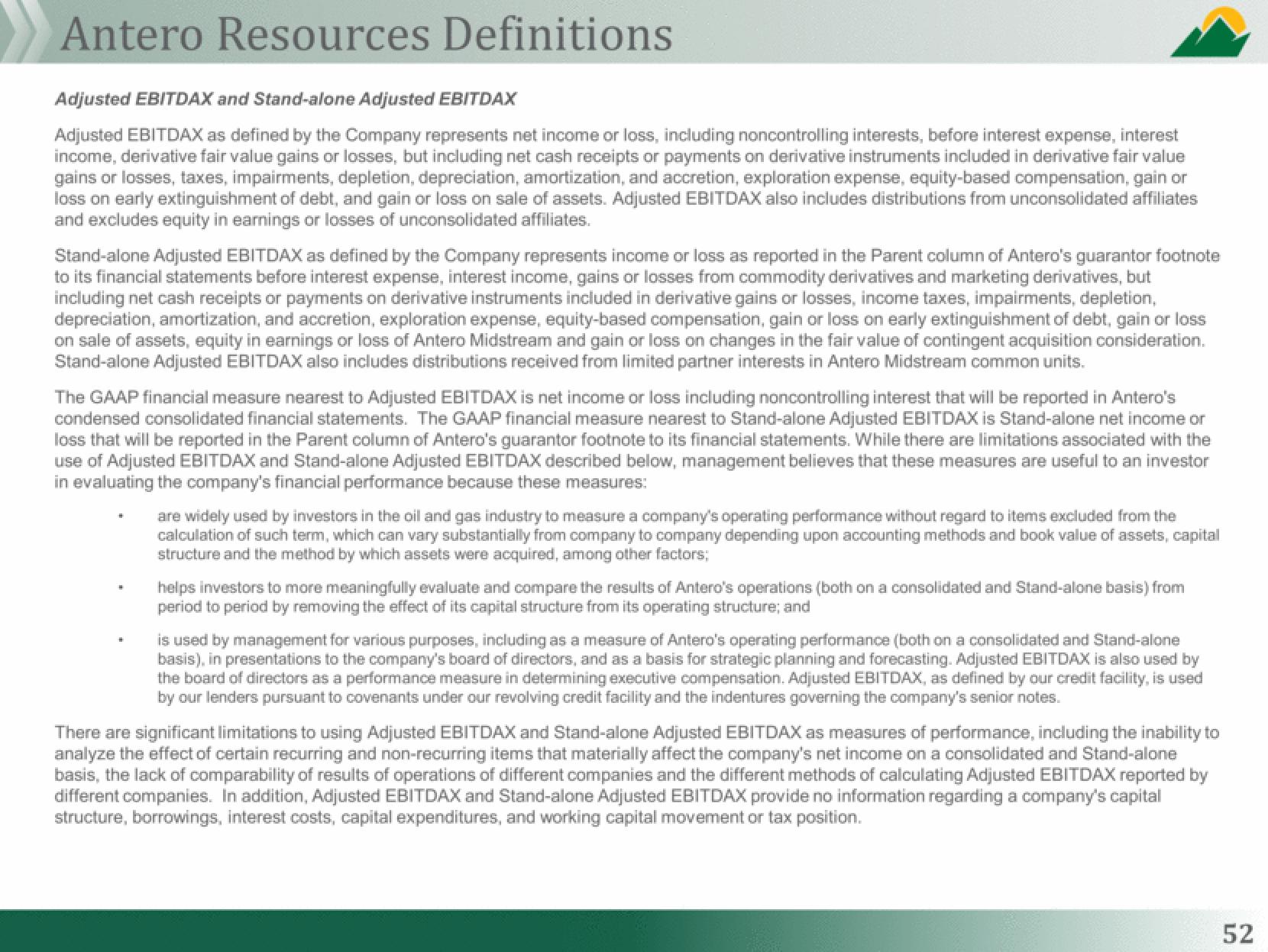Antero Midstream Partners Investor Presentation Deck
Antero Resources Definitions
Adjusted EBITDAX and Stand-alone Adjusted EBITDAX
Adjusted EBITDAX as defined by the Company represents net income or loss, including noncontrolling interests, before interest expense, interest
income, derivative fair value gains or losses, but including net cash receipts or payments on derivative instruments included in derivative fair value
gains or losses, taxes, impairments, depletion, depreciation, amortization, and accretion, exploration expense, equity-based compensation, gain or
loss on early extinguishment of debt, and gain or loss on sale of assets. Adjusted EBITDAX also includes distributions from unconsolidated affiliates
and excludes equity in earnings or losses of unconsolidated affiliates.
Stand-alone Adjusted EBITDAX as defined by the Company represents income or loss as reported in the Parent column of Antero's guarantor footnote
to its financial statements before interest expense, interest income, gains or losses from commodity derivatives and marketing derivatives, but
including net cash receipts or payments on derivative instruments included in derivative gains or losses, income taxes, impairments, depletion,
depreciation, amortization, and accretion, exploration expense, equity-based compensation, gain or loss on early extinguishment of debt, gain or loss
on sale of assets, equity in earnings or loss of Antero Midstream and gain or loss on changes in the fair value of contingent acquisition consideration.
Stand-alone Adjusted EBITDAX also includes distributions received from limited partner interests in Antero Midstream common units.
The GAAP financial measure nearest to Adjusted EBITDAX is net income or loss including noncontrolling interest that will be reported in Antero's
condensed consolidated financial statements. The GAAP financial measure nearest to Stand-alone Adjusted EBITDAX is Stand-alone net income or
loss that will be reported in the Parent column of Antero's guarantor footnote to its financial statements. While there are limitations associated with the
use of Adjusted EBITDAX and Stand-alone Adjusted EBITDAX described below, management believes that these measures are useful to an investor
in evaluating the company's financial performance because these measures:
W
are widely used by investors in the oil and gas industry to measure a company's operating performance without regard to items excluded from the
calculation of such term, which can vary substantially from company to company depending upon accounting methods and book value of assets, capital
structure and the method by which assets were acquired, among other factors;
helps investors to more meaningfully evaluate and compare the results of Antero's operations (both on a consolidated and Stand-alone basis) from
period to period by removing the effect of its capital structure from its operating structure; and
is used by management for various purposes, including as a measure of Antero's operating performance (both on a consolidated and Stand-alone
basis), in presentations to the company's board of directors, and as a basis for strategic planning and forecasting. Adjusted EBITDAX is also used by
the board of directors as a performance measure in determining executive compensation. Adjusted EBITDAX, as defined by our credit facility, is used
by our lenders pursuant to covenants under our revolving credit facility and the indentures governing the company's senior notes.
There are significant limitations to using Adjusted EBITDAX and Stand-alone Adjusted EBITDAX as measures of performance, including the inability to
analyze the effect of certain recurring and non-recurring items that materially affect the company's net income on a consolidated and Stand-alone
basis, the lack of comparability of results of operations of different companies and the different methods of calculating Adjusted EBITDAX reported by
different companies. In addition, Adjusted EBITDAX and Stand-alone Adjusted EBITDAX provide no information regarding a company's capital
structure, borrowings, interest costs, capital expenditures, and working capital movement or tax position.
52View entire presentation